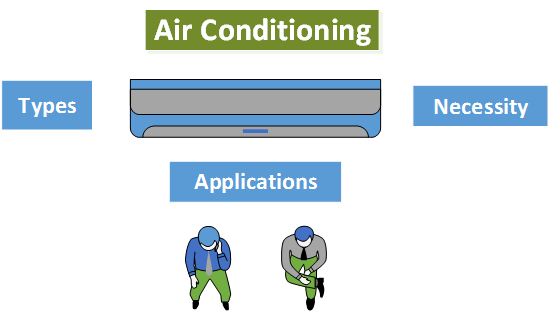Air conditioning is the branch of engineering science, which deals with
- the study of conditioning of air i.e. supplying and maintaining desirable internal atmospheric conditions.
- supply and maintaining desirable internal atmospheric conditions.

Necessity of Air Conditioning
- To provide human comfort under working condition either in industry, office or in research work so as to improve quality of work and productivity.
- To provide human comfort in summer or winter.
- Necessity for the rapid industrial development with the economic growth of the country.
- Necessity in many plants for controlling various manufacturing processes and properties of material to improve the quality of product.
- Necessary for maintaining accuracy of measuring instruments to obtain precise measurements and testing results.
Types of Air Conditioning
According to purpose, the air conditioning may be broadly classified in to two categories.
- Comfort air conditioning system
Purpose of this air conditioning system is to create internal atmospheric conditions conducive (desired) to human health, comfort and efficiency. This system is used for home, office, shop, restaurant, hospital, school etc.
- Industrial air conditioning system
Purpose of this air conditioning system is to control internal atmospheric conditions primarily essential for proper research and manufacturing processes. This type of air conditioning is used in textile mils, paper mills, machine parts manufacturing industry, tool rooms, printing, photo processing plant etc.
Applications of Air Conditioning
(1) Commercial applications of air conditioning:
Purpose:
(i) To provide comfort to people or occupants.
(ii) To provide desired conditions of temperature and humidity conducive to human health, which increases the working efficiency of staff working in commercial sectors, such as, offices, hospitals, public buildings etc.
Applications:
- Air conditioning for restaurants and hotels.
- Air conditioning for theatres and auditorium.
- Air conditioning of hospitals.
(2) Industrial applications of air conditioning:
Purpose:
- To provide comfort to industrial workers.
- To provide desired conditions of temperature and humidity for the various manufacturing processes in industries.
- For drying the products.
- To preserve food during storage and transport.
- To maintain clean atmosphere required for precise work.
Applications
- Air conditioning for textile industry: Used to produce quality fabrics.
- Maintenance of relative humidity is most important factor in case of cotton, nylon, silk, rayon and woollen industries.
- Low relative humidity is required in spinning department to avoid sticky action of cotton to leather apron.
- Photographic industry: Control of temperature, humidity and air filtration is essential in manufacturing of photographic materials and films.
- Transport air conditioning: For automobiles, railways and aircraft.
- Special applications Of air conditioning: Here, desired conditions are temperature of 18°C. DBT and relative humidity of 30% – 65%.
For example
- Air conditioning of computer centre.
- Air conditioning of T.V. centre.
- Air conditioning of telephone exchange building.
Difference between Industrial and Commercial Applications of Air Conditioning
| Commercial Applications of Air Conditioning | Industrial Applications of Air Conditioning |
| To obtain individual selected temperature. | To make precise measurements. |
| To obtain variable load with high peak. | To control temperature and humidity. |
| Zonal air distribution to maintain uniform condition. | Greatly depends on moisture control. |
| Occupancy and outdoor air used. | Industry needs refrigeration to reduce air borne bacteria and dirt to preserve products. |
| Remove bacteria outside. | Products deteriorate rapidly at high temperatures and high humidity. |
| To provide comfort air. | Manufacture of precision parts. |